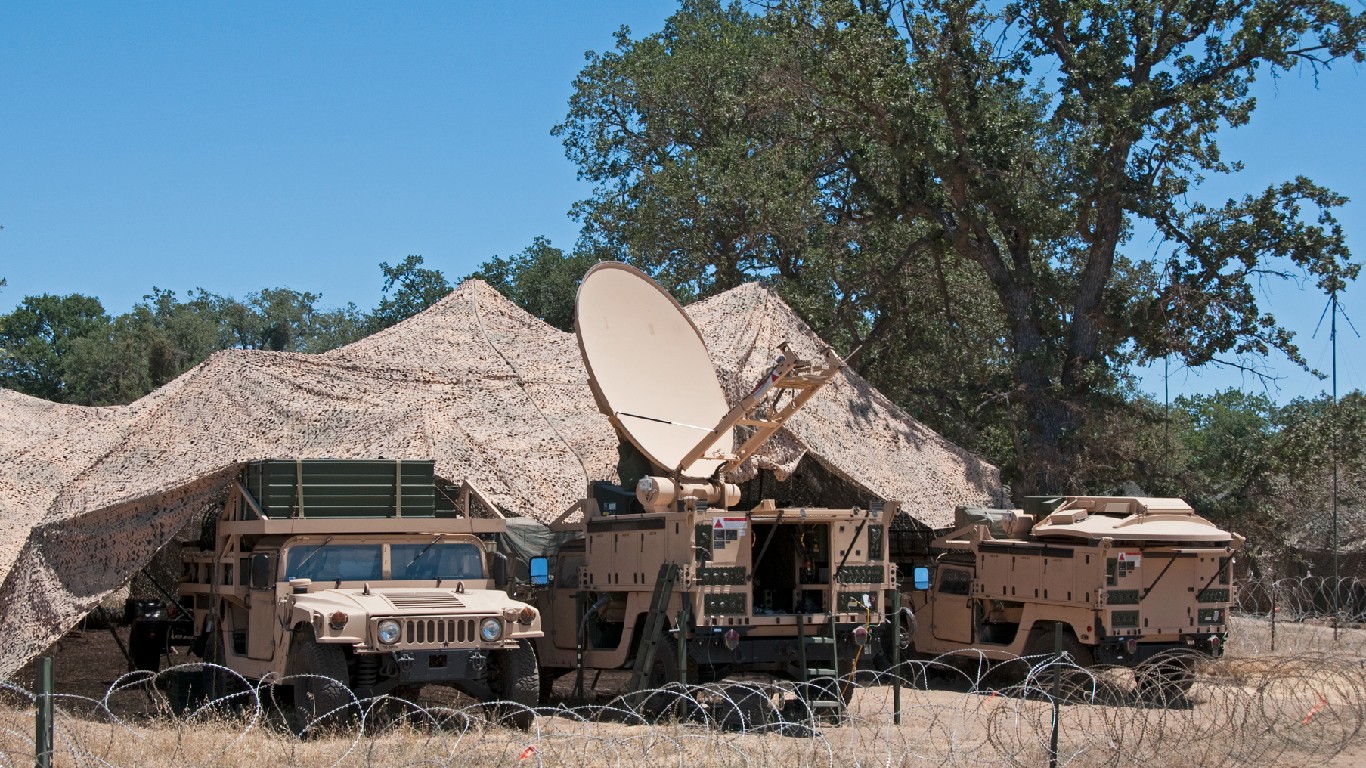
Only a decade into the Cold War, the Soviet Union successfully launched the first satellite into orbit. The event caused alarm in the United States, as the newly demonstrated technological capabilities of its No. 1 geopolitical foe had profound security implications. In response, the U.S. launched its own satellite and created the National Aeronautics and Space Administration, or NASA, the following year.
In the decades since, maintaining a presence in outer space has only grown more strategically important. Today, there are over 4,800 artificial satellites orbiting the Earth, and hundreds of them have been launched expressly for military purposes. While dozens of countries have deployed military satellites, the United States has a reported 231, by far the most. Here is a look at some popular commercial products invented by the military.
Military satellites have a wide range of uses. These include, but are not limited to, communications, reconnaissance, weather tracking, and navigation. Using data compiled by the Union of Concerned Scientists, a nonprofit organization, 24/7 Wall St. identified the countries with the most military satellites.
While there are limits to the uses of military satellites – including an internationally recognized ban on the installation of weapons of mass destruction – their use continues to expand rapidly. More than one in every four military satellites in orbit were launched in 2019 or later. Here is a look at 12 new weapons the U.S. is adding to its arsenal.
Perhaps not surprisingly, the military presence a given country has beyond Earth’s atmosphere is partially a reflection of its military spending. Generally, the more satellites a country has in orbit, the larger its defense budget.
Click here to see the country with the most military satellites
Click here to see our detailed methodology

27. Brazil
> Total military satellites: 1
> Annual military budget: $19.7 billion (1.4% of GDP)
[in-text-ad]

26. Canada
> Total military satellites: 1
> Annual military budget: $22.8 billion (1.4% of GDP)

25. Chile
> Total military satellites: 1
> Annual military budget: $4.6 billion (1.9% of GDP)
24. Colombia
> Total military satellites: 1
> Annual military budget: $9.2 billion (3.4% of GDP)
[in-text-ad-2]

23. Denmark
> Total military satellites: 1
> Annual military budget: $5.0 billion (1.4% of GDP)

22. Egypt
> Total military satellites: 1
> Annual military budget: $4.5 billion (1.2% of GDP)
[in-text-ad]

21. Iran
> Total military satellites: 1
> Annual military budget: $15.8 billion (2.2% of GDP)

20. Luxembourg
> Total military satellites: 1
> Annual military budget: $4.9 million (0.8% of GDP)

19. Qatar
> Total military satellites: 1
> Annual military budget: N/A
[in-text-ad-2]

18. South Africa
> Total military satellites: 1
> Annual military budget: $3.2 billion (1.1% of GDP)

17. Japan
> Total military satellites: 2
> Annual military budget: $49.1 billion (1.0% of GDP)
[in-text-ad]

16. South Korea
> Total military satellites: 2
> Annual military budget: $45.7 billion (2.8% of GDP)

15. Thailand
> Total military satellites: 2
> Annual military budget: $7.3 billion (1.5% of GDP)

14. Turkey
> Total military satellites: 2
> Annual military budget: $17.7 billion (2.8% of GDP)
[in-text-ad-2]

13. Mexico
> Total military satellites: 3
> Annual military budget: $6.1 billion (0.6% of GDP)

12. United Arab Emirates
> Total military satellites: 3
> Annual military budget: N/A
[in-text-ad]

11. Australia
> Total military satellites: 4
> Annual military budget: $27.5 billion (2.1% of GDP)

10. Spain
> Total military satellites: 4
> Annual military budget: $17.4 billion (1.4% of GDP)

9. United Kingdom
> Total military satellites: 6
> Annual military budget: $59.2 billion (2.2% of GDP)
[in-text-ad-2]

8. Germany
> Total military satellites: 7
> Annual military budget: $52.8 billion (1.4% of GDP)

7. Italy
> Total military satellites: 8
> Annual military budget: $28.9 billion (1.6% of GDP)
[in-text-ad]

6. India
> Total military satellites: 9
> Annual military budget: $72.9 billion (2.9% of GDP)

5. Israel
> Total military satellites: 11
> Annual military budget: $21.7 billion (5.6% of GDP)

4. France
> Total military satellites: 14
> Annual military budget: $52.7 billion (2.1% of GDP)
[in-text-ad-2]
3. Russia
> Total military satellites: 101
> Annual military budget: $61.7 billion (4.3% of GDP)

2. China
> Total military satellites: 139
> Annual military budget: $252.3 billion (1.7% of GDP)
[in-text-ad]

1. United States
> Total military satellites: 231
> Annual military budget: $778.2 billion (3.7% of GDP)
Methodology
To determine the country with the most military satellites, 24/7 Wall St. reviewed data compiled by the Union of Concerned Scientists, a nonprofit organization. Countries are ranked by the number of satellites in orbit as of Jan. 1, 2022 that are at least partially being used for military purposes. Countries with the same number of military satellites as one or more other countries are listed in alphabetical order. We only considered satellites that are owned and operated by a single country.
Supplemental data on military spending, listed in current U.S. dollars and as a share of gross domestic product, is from the World Bank and is for 2020, the most recent available year.
It’s Your Money, Your Future—Own It (sponsor)
Are you ahead, or behind on retirement? For families with more than $500,000 saved for retirement, finding a financial advisor who puts your interest first can be the difference, and today it’s easier than ever. SmartAsset’s free tool matches you with up to three fiduciary financial advisors who serve your area in minutes. Each advisor has been carefully vetted and must act in your best interests. Start your search now.
If you’ve saved and built a substantial nest egg for you and your family, don’t delay; get started right here and help your retirement dreams become a retirement reality.
Thank you for reading! Have some feedback for us?
Contact the 24/7 Wall St. editorial team.

 24/7 Wall St.
24/7 Wall St.

